Canadian
Research
Alberta
British
Columbia
Manitoba
New Brunswick
Newfoundland
Northern
Territories
Nova Scotia
Nunavut
Ontario
Prince Edward
Island
Quebec
Saskatchewan
Yukon
Canadian Indian
Tribes
Chronicles of
Canada
Free Genealogy Forms
Family Tree
Chart
Research
Calendar
Research Extract
Free Census
Forms
Correspondence Record
Family Group Chart
Source
Summary New Genealogy Data
Family Tree Search
Biographies
Genealogy Books For Sale
Indian Mythology
US Genealogy
Other Websites
British Isles Genealogy
Australian Genealogy
  
FREE Web Site Hosting at
Canadian Genealogy
|
Farm Scenes
These images are taken
from Wills's Cigarettes of England. They were issued by the
Imperial Tobacco Co of Great Britain and Ireland. 1914
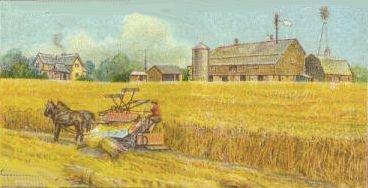 |
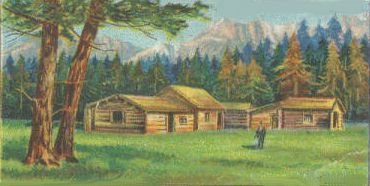 |
|
Canadian Farm
After a few years of successful agriculture the wooden
shanty of the pioneer farmer is replaced by a
substantially built house of stone, and up to date farm
buildings. Although the man who measures his property by
miles usually employs mechanical power for his ploughing,
harrowing, and reaping, the average Canadian farmer,
with his 100,300 acres, has to depend upon horses for
the same purpose. |
Settlers'
Ranch
The picture shows a group of roughly built log houses in
the West. Such structures as these serve many purposes;
for in the pioneer stage, dwelling-houses, stores and
Government offices are invariably timber built. So rapid
is the growth of townships and farms in Western Canada,
that this stage is usually very short, and before many
years have passed substantial stone buildings will
probably take the place of these log shanties. |
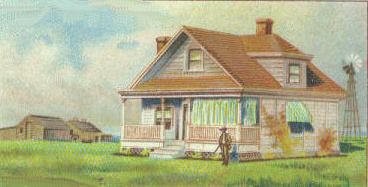 |
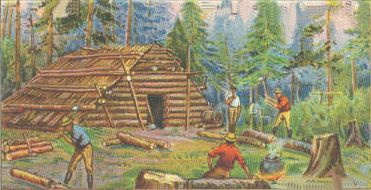 |
|
A Typical
Farmhouse
For many years past the pioneer farmer out West was
content to erect his rough dwelling of logs. Today,
however, even his temporary wooden residence is built in
much more artistic style, as will be seen by reference
to the picture. Thanks to the C.P.R., it is now possible
for the settler to purchase a "Ready-made Farm."
Provided with dwelling-house, barns, and stabling, and
with the land ready fenced and the first crops sown. |
Lumberman's
Camp
Lumbering is one of the oldest of Canadian industries;
for in 1769 William Davidson, the pioneer lumberman of
Canada, supplied masts to the British Navy. Today Canada
provides timber for many industries, ranging from
building to paper making. Every year thousands of men
spend the winter cutting timber. When the returning
spring thaws the ice, the logs are floated down the
waterways to the sawmills. |
|
 |
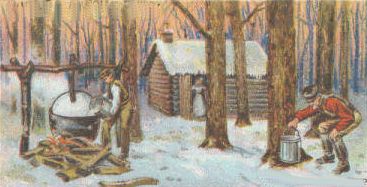 |
|
A New Town in the
West
In some of the Western Provinces new towns develop with
a rapidity that is almost incredible. Let us take
Edmonton, the capital of Alberta, as an illustration.
Less than 30 years ago. Edmonton was a mere fur trading
outpost in the wilderness. In 1890 it boasted a few
wooden shanties, and resembled the little township in
our illustration. In 1905 the population was 9,2000; and
by 1913 it had increased to 60,000.
|
Boiling Maple
Syrup
In early spring, when the sap begins to flow, the maple
trees are tapped, and vessels hung to catch the sap.
This is afterwards boiled down over a steady fire,
leaving the sweet dark colored maple syrup. For making
maple sugar the boiling is carried further, and the
liquid sugar is then run into moulds. The preparation of
maple syrup and sugar, which is an extensive industry in
Canada, was originally carried on by the Indians. |
Previous |
Index |
Next
Canada in
Pictures |